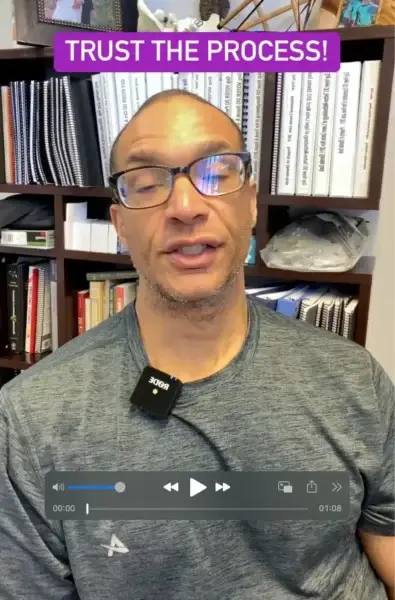
“Trust the process.” Coaches, mentors, therapists all say it at some point. But what does it actually mean for your health, your progress, and your long-term results? Most people get excited to start a new journey be it a fitness plan, recovery routine, or life overhaul but lose steam when results don’t come instantly. The truth is, any meaningful change comes from steady engagement with the process, not from chasing overnight breakthroughs.
Why Trusting the Process Is So Hard
Let’s be honest: we live in an instant-results culture. Order today, it’s shipped tomorrow. Click “like,” get a dopamine hit. Even in wellness, we’re bombarded with “30-day transformation” promises. But in the real world, true change looks more like a slow sunrise a gradual lightening, not a dramatic flash.
Client Story: “Travis and the Patience Game”
Travis was a cross fitter who injured his shoulder a mild tear that ended up needing months of work. Used to fast results, he grew frustrated by slow rehab: “Why am I not 100% after 4 weeks?” His turning point came when he realized each week brought small wins better sleep, less inflammation, a pain-free workday. By the 9th week, his “small wins” had added up to big progress but only because he surrendered to steady, thoughtful work and stopped chasing shortcuts.
The Four Stages of Real Change
- Uninformed Optimism: At first, you’re excited, hopeful, and ready to work. Easy wins come quickly (weight drops, energy surges, pain decreases a bit).
- Informed Pessimism: Progress slows or plateaus. Challenges multiply. Doubt arrives: “Is this working?”
- Valley of Despair: You face setbacks, mental fatigue, maybe even crisis (“I blew it—maybe I’ll quit”).
- Informed Optimism: Consistency starts paying off. Skills become natural, new strength or mobility returns, confidence soars.
The catch? Only those who trust the process make it to the fourth stage.
“Trust” Means Active, Not Passive
Trusting the process isn’t about blind faith or passivity—it’s about active participation. That means:
- Showing up, even when you don’t feel motivated
- Recording data (rest, sleep, mood, pain, wins, setbacks)
- Communicating honestly with your coach or therapist
The Hidden Magic of Accountability
Self-guided change is possible—but community support, expert guidance, and outside “eyes” make progress easier, faster, and more fun. At SolCore, clients who stick to regular check-ins are far more likely to stay on track, adjust when obstacles arise, and celebrate progress at every stage.
Why Resets Take Time: Physiology and Mindset
- Tissues need to adapt: Fascia, muscle, and joints repair slowly—three months for new collagen, six for tendon strength.
- Nervous system rewiring: Habits are entrenchments in your nervous system; remapping takes countless reps and positive exposures.
- Mindset maturity: Only by repeating the process through multiple setbacks do you really internalize resilience.
Story: “Naomi’s Year of Change”
Naomi came for osteopathic therapy after years of back pain and “failed” programs. We set realistic goals, focused on gradual posture changes, and celebrated every micro-victory. Six months in, her pain was 50% better but—more importantly—she was empowered to coach herself out of setbacks. By the one-year mark, she was not only pain-free, but confident, consistent, and self-motivated.
How to Enjoy (or At Least Honor) the Process
- Set micro-goals: Track minutes walked, water drunk, or stretches performed—not just big milestones.
- Document how you feel: Notice energy, sleep, focus. Progress is about wholeness, not just metrics.
- Forgive yourself for dips: Setbacks are normal—not a sign of failure, but of growth.
- Ask for reminders: Let your coach or teammates cheer you on through hard phases.
When to Adjust (Not Quit) the Process
If you’re consistent but not seeing any change after several months, it’s time for honest feedback and perhaps expert reassessment. Sometimes the path requires adjustment, not abandonment.
Role of Osteopathic Manual Therapy
Osteopathic manual therapy supports the process by:
- Diagnosing small blockages and imbalances that sabotage progress
- Resetting tissue and alignment so new habits can “stick” faster
- Encouraging patients to be participants, not just patients
Clients often say: “The hands-on session lit a spark for faster breakthroughs—because it built on months of honest work at home.”
Final Words: Embrace the Long Game
Great change is never “done”; it’s a lived, evolving process. There’s joy, strength, and pride in mastery not just results. Whether you’re starting today or starting over for the tenth time, the key is to trust the process, show up, and welcome the learning journey itself.
Ready for guidance and support? Book a session with us for osteopathic manual therapy or a consult on your next training phase. Let’s build something that lasts together.
It’s not just working out, it’s building a foundation for a better life.
Find out more @

Leave a Reply